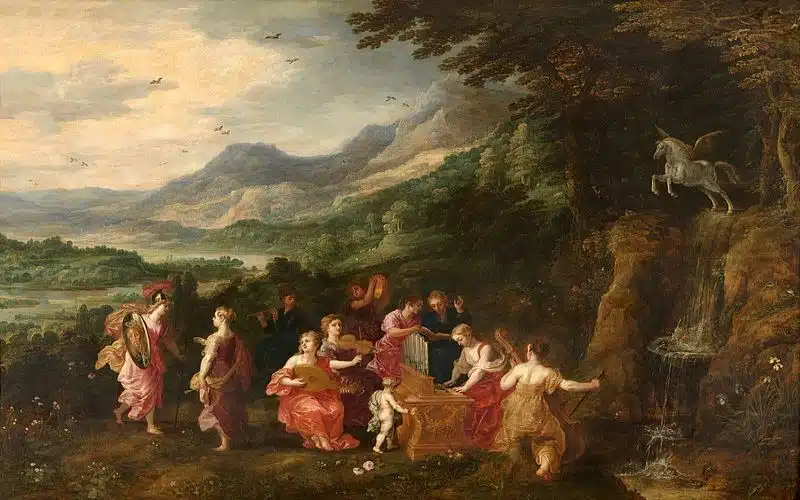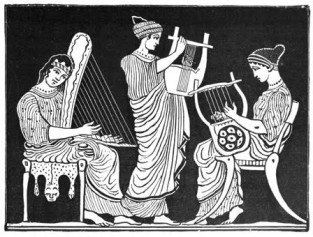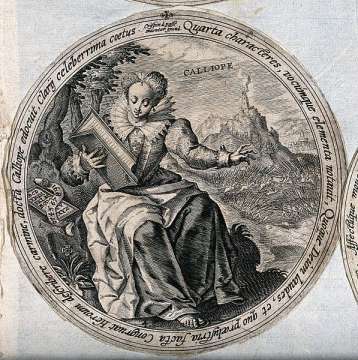The Muses, daughters of Zeus and the goddess of Memory, Mnemosyne, were charged with the responsibility of inspiring poets and musicians and promoting the arts and sciences.
No banquet on Mount Olympus was complete without them. Seated near the throne of their father, the nine sisters entertained the guests, singing not only about the greatness of Zeus but about the marvelous feats of the Greek heroes and the creation of the heavens and the earth with all its wondrous creatures.
Their influence was profound. By their praising valiant behavior, thereby etching their names in history, the Muses encouraged further heroism. Although they usually sang only for the immortals, they occasionally performed at events honoring heroic mortals, such as the funeral of Achilles, the fallen hero of the Trojan War.
The Power of Muses
They were described as “having one mind, their hearts set upon song and their spirit free from care.” The Muses often acted in concert, all were friends and followers of the god Apollo. On many occasions, their wise counsel, as well as their soothing diversions, kept him from making poor decisions.
Their gift, according to Hesiod, was that “though a man has sorrow and grief in his soul, when the Muses sing, at once he forgets his dark thoughts and remembers not his troubles.” A precious gift indeed.
The Unforgiving Nature of Muses
This is not to say, however, that all was goodness and light around them. Like many of the other deities, they were particularly sensitive about being acknowledged for their superiority.
When Pierus claimed his nine daughters were better singers, the Muses were mightily offended and turned the upstarts into magpies, ducks, finches, and other birds.
When the minstrel, Thamyris, challenged them to a song contest, he paid dearly for the affront. He, of course, lost the contest, but they also blinded him and took his memory away, rendering him unable to remember the words to his songs.
The Generosity of Muses
However, the Muses were also generous with their skills and willing to teach others. They taught the nymph Echo to play music, instructed the Egyptian Sphinx in her riddle, and trained the great poet Musaeus.
Calliope, the eldest, often attended the birth of royal nobles and gave (or withheld if she wished) the gift of the Muses as the immortals deemed fit. Mortals who were blessed by the Muses could use the beauty of song or the spirit of dance to heal the sick and to comfort the heartbroken.
Division of Skills

Even though they were almost always together and acting as one, each of the muses had her own area in which she excelled.
Calliope
A Muse of philosophy, epic poetry, and rhetoric, Calliope was the unofficial leader of Muses. She was often depicted wearing a writing tablet or a paper roll in her hand and with a golden crown on her head.
She gave birth to Orpheus and Linus, and both of them became famous musicians and bards of Ancient Greece. Calliope was also the Muse that inspired Homer to write Iliad and the Odyssey. Roman epic poet, Virgil, invokes Calliope in his most famous work, Aeneid.
Clio
A Muse of history and introduction of the alphabet in Greece, Clio was often represented holding an open parchment scroll or a book. Apart from being the Muse of history, Clio was also famous for playing the lyre and was often depicted holding one.
Clio’s name originated from the Greek word Kleio, which means “to make someone famous.” Indeed, this Muse had the power to make people famous and renowned by immortalizing their deeds.
Euterpe
She was a Muse of lyric poetry and music, especially the flute. As such, she was often depicted holding this instrument. Euterpe also discovered several other musical instruments, courses, and dialectics.
Music was an essential part of people’s lives, even in Ancient Greece. As a result, Euterpe’s name meant “delight” in Greek, and many poets and artists called Euterpe “the bringer of delight.”
Thalia
A Muse of comedy and pastoral poetry, Thalia was usually depicted as a mischievous young woman. She would often be holding a comedic mask, an ivy crown, and boots. Her name meant “festive, joyous, and flourishing.”
Thalia inspired countless Greek comedic writers, such as Menander and Aristophanes. Oftentimes, Greek comedies contained various philosophical thoughts. This was a clever and safe way to talk about more serious issues. Masking them in comedy, just like Thalia liked to mask her face.
Melpomene
Melpomene is a Muse initially responsible for chorus and chanting. Later she became responsible for tragedy (theater), which is her main responsibility now. Her name means to celebrate through dance and song.
As a Muse of tragedy, Melpomene is often depicted wearing a tragic mask. Usually holding a knife or club in her hand, and wearing cothurnus (boots traditionally worn by Greek tragedy actors). Invoking Melpomene was a common practice among Greek and Roman writers and poets.
Terpsichore
She was the Muse of dance and choral songs. One would expect Terpsichore to be depicted as dancing, but surprisingly enough, she is usually depicted as sitting down. With a lyre in her hands, Terpsichore accompanies dancers and provides music to which they dance.
Terpsichore was the mother of Sirens, also famous mythical creatures. She also gave birth to two Thracian kings: Boston and Rhesus.
Erato
One of the most famous Muses, and certainly the Muse that caused the most heartache, Erato is the Muse of love poems and mimicry. Often accompanied by the God of Love, Eros, Erato inspired poets and artists to create the most passionate works of art.
Erato was mentioned by Apollonius Rhodius in his work Argonautica. At the beginning of this story, Rhodius invokes Erato to tell him a story of the love between Medea and Jason.
Polyhymnia
A Muse of sacred music and eloquence in verse, Polyhymnia was depicted as a serious woman dressed in a long cloak and veil, holding a finger to her mouth. Apart from her main responsibilities, Polyhymnia was the protector of agriculture, pantomime, geometry, and meditation.
She inspired famous orators, the most famous being Demosthenes. He wrote Philippics, a famous speech that was supposed to unite Athenians and other Greeks against the upcoming invasion of King Philip of Macedonia.
Ourania
A Muse that inspired not only arts but also scientific thought, Ourania was the Muse of astronomy, astrology, and prophecy. That’s why she was often depicted holding a compass or globe.
Many considered Ourania the eldest Muse, as she inherited the power and majesty from her father, the mighty Zeus. She also inherited beauty and grace from her mother, Mnemosyne.
Interacting With Other Deities
Although none of the Muses have an extensive mythology of their own, many of them are featured in other myths.
Calliope, for example, was called on by Zeus to arbitrate the dispute between Aphrodite and Persephone. After they both fell in love with the handsome Adonis. Her wise decision to allow him to spend part of the year with each of them seemed to satisfy everyone.
When Athena rescued Pegasus, the flying horse, shortly after his birth, the goddess entrusted the Muses with his care. The young colt, excited to meet the lovely Muses, kicked the side of the Mountain. Causing springs to gush out of the side of the mountain.
Springs and wells both became sacred symbols of the Muses. Coming to represent the fountains of inspiration that they provided. Ourania took the major responsibility for caring for Pegasus and prophesied his future heroism. She also foresaw his eventual place amongst the stars in the heavens.
Goddess Jewelry
There are many reasons why you might want to keep a healing crystal or stone close to you. Getting closer to your goddess by wearing her color or crystal is a great one. That they also look great as jewelry only makes it so much better!
Here is a guide to crystal jewelry you hopefully will find helpful. In it is a list of 30+ crystals and links to some really great looking jewelry with that crystal or stone. Enjoy!
Embracing the Call of The Muses: Recognizing Their Presence and Cultivating a Sacred Connection
Have you ever felt inspired by music, art, or literature and wondered if there’s a deeper connection? For many, the Greek goddesses known as The Muses may be extending an invitation to connect. Discover how to recognize the signs of their calling, invoke their presence, and cultivate a meaningful relationship with these powerful goddesses.
How to know if The Muses are calling you
One way to recognize The Muses’ call is through creative inspiration. Sudden bursts of creativity, new ideas, or an unexplained drive to express yourself may be signs. Pay attention to the specific art forms that resonate with you, as each Muse governs a different discipline.
Dreams and visions are another way The Muses may reach out. Dreams featuring the goddesses or their symbols, like musical instruments or artistic tools, can be significant. Similarly, visions of creative works or artistic spaces might signal their presence.
Finally, note the synchronicities in your life. Repeated encounters with their symbols, or a strong attraction to stories and mythology involving The Muses, can indicate they are calling you. These patterns may seem coincidental, but they’re worth observing.
Invoking The Muses
To call upon The Muses, create a space that embodies creativity and inspiration. Incorporate their symbols, such as musical instruments, art supplies, or images of the goddesses into your chosen area. This will help establish a connection with them.
During your ritual, light candles in various colors, representing the diversity of their domains. Offer symbols of The Muses, such as artwork, poetry, or other creative expressions. These offerings demonstrate your dedication and respect for the goddesses.
In meditation, focus on your breath and clear your mind. Visualize The Muses, their symbols, and the energy they embody. Quietly ask for their guidance, and be open to any insights that may arise during your meditation.
Signs that The Muses are present
Recognizing when The Muses are with you is essential to deepening your connection with them. The goddesses often manifest their presence in various ways, from emotional sensations to visual cues. Here are six signs to help you identify when The Muses are near:
- Emotional sensations: Feelings of inspiration, creativity, or motivation can indicate their presence.
- Physical reactions: Sudden warmth, tingling sensations, or goosebumps may signal they’re near.
- Visual cues: Flashes of colorful light, moving shadows, or glimpses of their symbols can be signs.
- Auditory cues: Hearing music, whispers, or poetic phrases may suggest their presence.
- Creative occurrences: Unusual artistic breakthroughs or moments of clarity can be signals.
- Intuitive connection: A strong sense that The Muses are with you, even if you can’t pinpoint why, can be a sign of their presence.
Cultivating a relationship with The Muses
To build a deeper connection with The Muses, establish a consistent practice of meditation, prayer, or ritual to honor them. Make regular offerings, such as your creative work, to demonstrate your commitment to the goddesses.
Embrace their values by nurturing creativity and artistic expression in your life. Support the arts and engage with other artists, as these connections are central to their being. Aligning your life with their principles will help deepen your connection to them.
Lastly, study their mythology and history. Read about The Muses and their place in Greek mythology, and engage with others who share your interest. By exchanging insights and experiences, you’ll develop a richer understanding of the goddesses and strengthen your bond with them.
Legacy
The Muses remain among us today as the patrons of the fine arts and the inspiration for creative thought. Even if Mnemosyne herself ironically isn’t remmebered as well, her daughters of wit and charm are remembered. Their legacy lives on through popular culture, as they never stopped inspiring us.
Other Goddesses
We hope you enjoyed reading this post. Make sure to check out some of the other goddesses on here. as well. You can find the complete list of goddesses sorted across regions and religions here.
Featured Image Credit: Hendrick van Balen the Elder, Joos de Momper, Jan Brueghel the Elder, Public domain, via Wikimedia Commons




